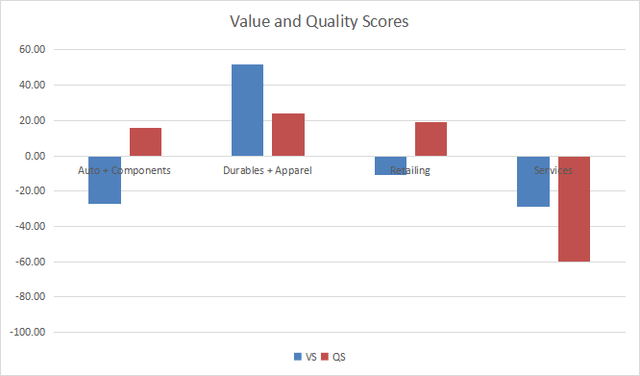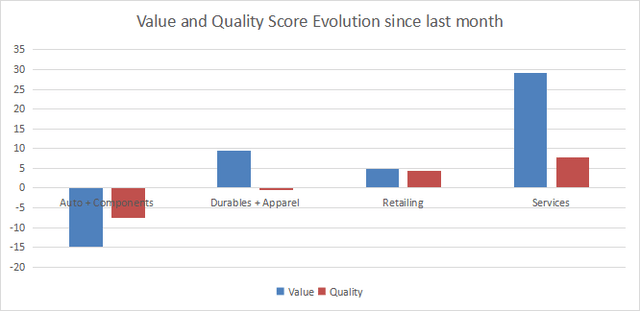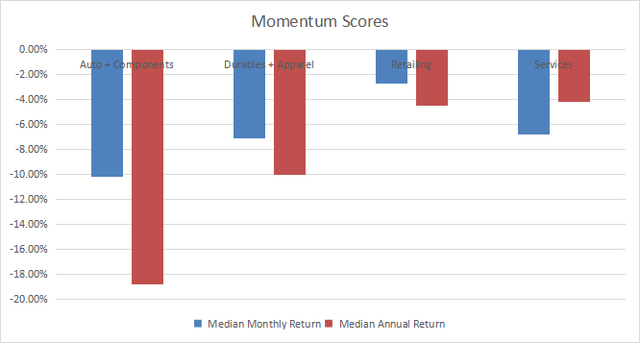[ad_1]

eclipse_images/E+ via Getty Images
This monthly article series shows a dashboard with aggregate subsector metrics in Consumer Discretionary. It is also a top-down analysis of sector ETFs like the Consumer Discretionary Select Sector SPDR ETF (XLY) and the Vanguard Consumer Discretionary ETF (NYSEARCA:VCR), whose largest holdings are used to calculate these metrics.
Shortcut
The next two paragraphs in italic describe the dashboard methodology. They are necessary for new readers to understand the metrics. If you are used to this series or if you are short of time, you can skip them and go to the charts.
Base Metrics
I calculate the median value of five fundamental ratios for each subsector: Earnings Yield (“EY”), Sales Yield (“SY”), Free Cash Flow Yield (“FY”), Return on Equity (“ROE”), Gross Margin (“GM”). The reference universe includes large companies in the U.S. stock market. The five base metrics are calculated on trailing 12 months. For all of them, higher is better. EY, SY and FY are medians of the inverse of Price/Earnings, Price/Sales and Price/Free Cash Flow. They are better for statistical studies than price-to-something ratios, which are unusable or non-available when the “something” is close to zero or negative (for example, companies with negative earnings). I also look at two momentum metrics for each group: the median monthly return (RetM) and the median annual return (RetY).
I prefer medians to averages because a median splits a set in a good half and a bad half. A capital-weighted average is skewed by extreme values and the largest companies. My metrics are designed for stock-picking rather than index investing.
Value and Quality Scores
I calculate historical baselines for all metrics. They are noted respectively EYh, SYh, FYh, ROEh, GMh, and they are calculated as the averages on a look-back period of 11 years. For example, the value of EYh for retailing in the table below is the 11-year average of the median Earnings Yield in retail companies.
The Value Score (“VS”) is defined as the average difference in % between the three valuation ratios (EY, SY, FY) and their baselines (EYh, SYh, FYh). The same way, the Quality Score (“QS”) is the average difference between the two quality ratios (ROE, GM) and their baselines (ROEh, GMh).
The scores are in percentage points. VS may be interpreted as the percentage of undervaluation or overvaluation relative to the baseline (positive is good, negative is bad). This interpretation must be taken with caution: the baseline is an arbitrary reference, not a supposed fair value. The formula assumes that the three valuation metrics are of equal importance. A floor of -100 is set for VS and QS when the calculation goes below this value. It may happen when metrics in a subsector are very bad.
Current Data
The next table shows the metrics and scores as of last week’s closing. Columns stand for all the data named and defined above.
|
VS |
QS |
EY |
SY |
FY |
ROE |
GM |
EYh |
SYh |
FYh |
ROEh |
GMh |
RetM |
RetY |
|
|
Auto + Components |
-27.15 |
15.59 |
0.0573 |
0.8644 |
0.0278 |
20.31 |
27.57 |
0.0602 |
1.6483 |
0.0392 |
19.26 |
21.93 |
-10.20% |
-18.79% |
|
Durables + Apparel |
51.71 |
24.06 |
0.0669 |
0.7163 |
0.0701 |
28.10 |
42.55 |
0.0501 |
0.6985 |
0.0320 |
17.73 |
47.49 |
-7.08% |
-10.05% |
|
Retailing |
-10.99 |
19.30 |
0.0505 |
0.6484 |
0.0383 |
34.62 |
34.51 |
0.0501 |
0.9079 |
0.0404 |
24.04 |
36.48 |
-2.71% |
-4.45% |
|
Services |
-29.10 |
-59.83 |
0.0139 |
0.2570 |
0.0249 |
-1.29 |
31.93 |
0.0354 |
0.4195 |
0.0222 |
14.90 |
35.87 |
-6.80% |
-4.16% |
Value and Quality Chart
The next chart plots the Value and Quality Scores by subsector (higher is better).

Value and Quality in consumer discretionary (Chart: Author; data: Portfolio123)
Evolution Since Last Month
Recently, the value score has improved a lot in services and deteriorated in auto and components.

Evolution in Value and Quality (Chart: Author; data: Portfolio123)
Momentum
The next chart plots momentum data.

Momentum in consumer discretionary (Chart: Author; data: Portfolio123)
Interpretation
Durables and apparel are undervalued relative to 11-year averages. It is the best-ranked subsector of consumer cyclicals in both value and quality scores. Retailing is slightly overvalued, but this may be justified by a good quality score. The services subsector, which includes hotels, restaurants, leisure and diversified services, has bad fundamental metrics. The median ROE is negative, meaning that most companies in this subsector are unprofitable regarding this metric on a trailing twelve months basis. It has improved a lot in the last months, but many companies have increased their debt burdens in two years. Moreover, some consumer habits may have changed in a lasting way.
Focus on VCR
The Vanguard Consumer Discretionary ETF has been tracking the MSCI US IMI Consumer Discretionary 25/50 Index since 01/26/2004. It has 306 holdings and a total expense ratio of 0.10%, which is a bit lower than XLY (0.12%).
The next table shows the top 10 holdings with basic ratios and dividend yields. Their aggregate weight is 59%, with over 36% in the top two names. Amazon.com, Inc. (AMZN) and Tesla (TSLA) represent 22.84% and 13.33% of the fund’s asset value.
|
Ticker |
Name |
Weight |
EPS ttm growth% |
P/E ttm |
P/E fwd |
Yield% |
|
AMZN |
Amazon.com, Inc. |
22.84% |
55.25 |
48.51 |
64.60 |
0.00 |
|
TSLA |
Tesla, Inc. |
13.33% |
678.38 |
178.14 |
80.70 |
0.00 |
|
HD |
Home Depot, Inc. |
6.23% |
29.92 |
21.68 |
20.91 |
2.26 |
|
MCD |
McDonald’s Corp. |
3.47% |
59.16 |
23.66 |
23.57 |
2.32 |
|
NKE |
NIKE, Inc. Class B |
3.30% |
117.41 |
33.40 |
35.04 |
0.96 |
|
LOW |
Lowe’s Companies, Inc. |
2.83% |
54.67 |
19.58 |
17.37 |
1.37 |
|
SBUX |
Starbucks Corp. |
2.06% |
566.25 |
23.64 |
26.24 |
2.24 |
|
TGT |
Target Corp. |
1.83% |
62.75 |
15.68 |
15.22 |
1.63 |
|
BKNG |
Booking Holdings Inc. |
1.70% |
1861.56 |
76.83 |
24.63 |
0.00 |
|
TJX |
TJX Companies, Inc. |
1.53% |
4323.57 |
23.03 |
19.46 |
1.67 |
Ratios by Portfolio123
VCR has beaten XLY by a short margin of 35 bps in annualized return since inception. Both ETFs have very similar risk metrics (see next table).
|
Since Feb. 2004 |
Total Return |
Annual Return |
Drawdown |
Sharpe |
Volatility |
|
VCR |
662.64% |
11.86% |
-61.54% |
0.62 |
18.83% |
|
XLY |
620.52% |
11.51% |
-59.05% |
0.64 |
17.61% |
Data calculated with Portfolio123
In summary, VCR is a good product with cheap management fees for investors seeking capital-weighted exposure in consumer cyclicals. It currently holds 306 stocks including large, mid and small caps, whereas XLY has only 61 holdings in large companies. However, it doesn’t make a significant difference in risk-adjusted performance between the two funds since 2004: tail holdings have a low aggregate weight relative to S&P 500 companies. VCR looks like a good choice for long-term investors, but XLY liquidity makes it a better instrument for tactical allocation and trading. Investors must be aware that 23% of VCR asset value is in a single stock (AMZN). If it is a concern, a better choice is the Invesco S&P 500 Equal Weight Consumer Discretionary ETF (RCD).
Dashboard List
I use the first table to calculate value and quality scores. It may also be used in a stock-picking process to check how companies stand among their peers. For example, the EY column tells us that a retail company with an Earnings Yield above 0.0505 (or price/earnings below 19.8) is in the better half of the industry regarding this metric. A Dashboard List is sent every month to Quantitative Risk & Value subscribers with the most profitable companies standing in the better half among their peers regarding the three valuation metrics at the same time. The list below was sent to subscribers several weeks ago based on data available at this time.
|
BLMN |
Bloomin’ Brands, Inc. |
|
PLCE |
Children’s Place, Inc. |
|
WHR |
Whirlpool Corp. |
|
WSM |
Williams-Sonoma, Inc. |
|
MUSA |
Murphy USA Inc. |
|
F |
Ford Motor Company |
|
AN |
AutoNation, Inc. |
|
HIBB |
Hibbett, Inc. |
|
M |
Macy’s, Inc. |
|
SBH |
Sally Beauty Holdings, Inc. |
It is a rotating list with a statistical bias toward excess returns in the long term, not the result of an analysis of each stock.
[ad_2]
Source links Google News

